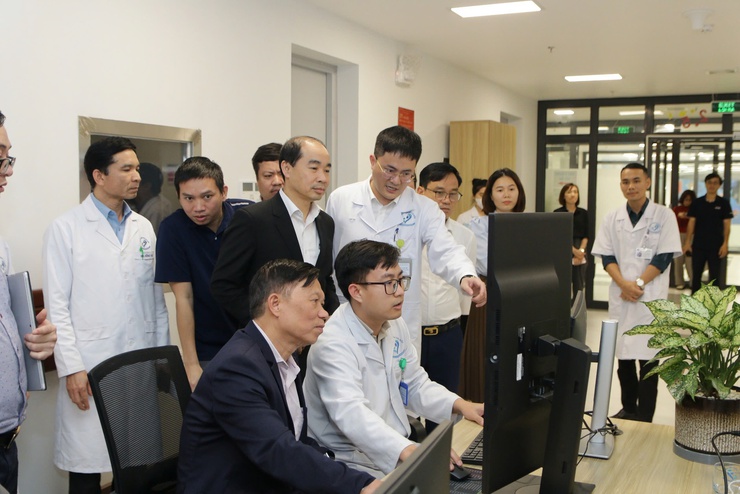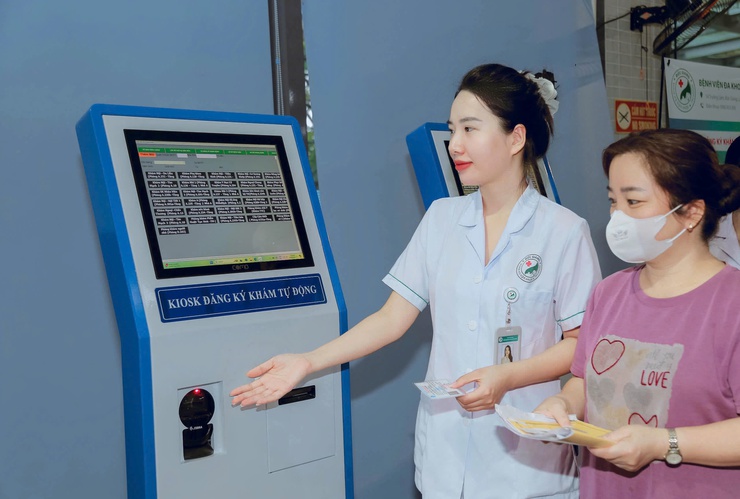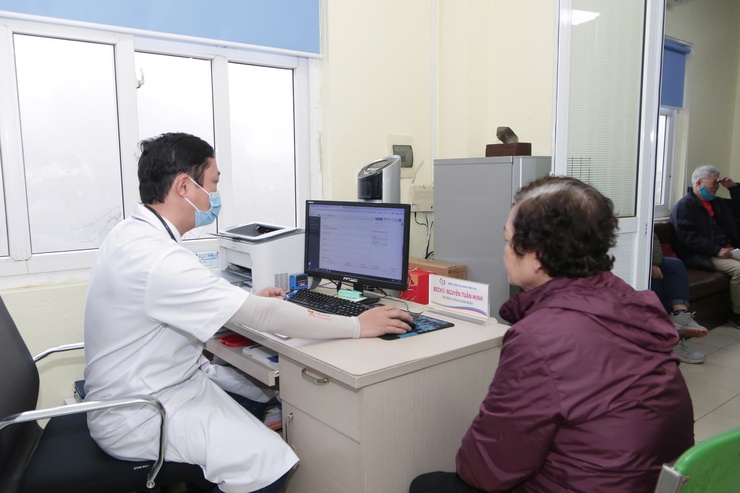The implementation of electronic medical records (EMRs) is seen as a crucial step in the digital transformation of healthcare. EMRs not only help reduce paperwork and save costs but also bring practical benefits to patients, medical facilities, and the entire healthcare management system.

Dr. Nguyen Dinh Hung, Acting Deputy Director of the Hanoi Department of Health, reviews the implementation of electronic medical records at Hanoi Pediatric Hospital.
EMRs serve as a system that manages all citizens' health information throughout the process of medical examination and treatment at healthcare facilities. This includes personal data, medical history, test results, medical imaging, prescriptions, and more—stored and continuously updated using electronic means.
In addition to benefits for the public, EMRs also help healthcare facilities save on operational and storage costs for paper records. At Saint Paul General Hospital, EMRs were piloted in 2021 during the height of the COVID-19 pandemic. The hospital pushed forward with infrastructure upgrades, workforce training, and patient guidance to digitize medical records, with the goal of implementing EMRs across all medical facilities. The hospital has integrated face recognition into the registration process, allowing patients to be identified using chip-based ID cards and health insurance cards at their first visit. From the second visit onward, patients no longer need to bring physical documents, saving time on procedures and allowing quicker access to quality healthcare services. Thanks to the benefits brought by digitizing EMRs, Saint Paul General Hospital has helped reduce pressure on medical staff and gained public support, laying the groundwork for modernizing the healthcare sector and improving public health protection.
According to Dr. Nguyen Van Thuong, Director of Duc Giang General Hospital, implementing EMRs saves significant time for both patients and medical staff. "Doctors have almost full access to a patient's medical record within minutes on a computer." Previously, patients often had to wait until the following day to complete discharge procedures. Now, with digital management in place, patients at Duc Giang General Hospital can quickly and easily complete discharge and payment procedures.

Locals at Duc Giang General Hospital
At Van Dinh General Hospital in Ung Hoa District, the introduction of EMRs marks a major step forward in the journey toward digital transformation and smart hospital development. Since 2023, the hospital has implemented a synchronized Hospital Information System (HIS), followed by a Laboratory Information System (LIS), a Picture Archiving and Communication System (PACS), and a hospital app. The successful deployment of EMRs has laid an important foundation for the hospital's digital transformation toward a smart, professional, and modern operational model.
Currently, 11 out of 42 public hospitals under Hanoi's Department of Health have completed EMR implementation. These include Saint Paul General Hospital, Hanoi Obstetrics and Gynecology Hospital, Hanoi Oncology Hospital, Dong Anh General Hospital, Van Dinh General Hospital, Hoe Nhai General Hospital, Soc Son General Hospital, Ba Vi District General Hospital, Quoc Oai District General Hospital, My Duc District General Hospital, and Hanoi Children's Hospital—representing 26.2% of the total. Additionally, 100% of public healthcare facilities now accept chip-based citizen ID cards and VNeID accounts in place of health insurance cards for medical services.
The Hanoi Department of Health has directed all public and private healthcare facilities under its management to urgently implement EMRs, in accordance with the government's directive, with a deadline of September 30, 2025.
Furthermore, five hospitals in the city are operating remote medical examination and treatment systems (Telehealth), as per the Ministry of Health's decision. These include Hanoi Heart Hospital, Hanoi Obstetrics and Gynecology Hospital, Hanoi Oncology Hospital, Saint Paul General Hospital, and Thanh Nhan Hospital. The Department of Health also regularly conducts virtual briefings with hundreds of medical facilities, both public and private.

Patients visiting Dong Da General Hospital are managed through specialized software.
In particular, Hanoi's health sector has begun piloting the application of artificial intelligence (AI) in medical examination and treatment at Saint Paul and Duc Giang General Hospitals. These include AI for diagnostic imaging in chest X-rays, AI-assisted screening of chest radiographs, AI in gastrointestinal endoscopy at the Saint Paul Center for Advanced Technology and Gastroenterology, and AI-based facial recognition for direct patient check-in at the hospital reception. Additionally, several facilities are piloting virtual reality (VR) for psychological treatment and rehabilitation.
Dr. Nguyen Dinh Hung, Acting Director of Hanoi's Department of Health, affirmed: "The application of information technology and digital transformation in healthcare is an inevitable development trend. This is very beneficial for the public and the healthcare sector, facilitating the work of physicians. Implementing electronic medical records is a significant breakthrough in the digital transformation of the healthcare sector. Hopefully, more hospitals in the city will soon implement EMRs for medical examination and treatment, making it easier and more convenient to manage public health records."
Deploying EMRs alongside electronic health records helps the health sector build a complete, accurate, and timely health data system. This large-scale database (big data) enables the synthesis and analysis of information for timely decision-making in disease prevention and contributes to trend forecasting and policy planning—enhancing the effectiveness of public healthcare services.
Dr. Nguyen Dinh Hung also shared that Hanoi has piloted electronic health records and digital health books citywide, connected and shared medical data for health insurance services, and enhanced data interoperability. This has helped create a digital work environment and digital mindset, ensuring transparency and convenience for citizens accessing medical services.